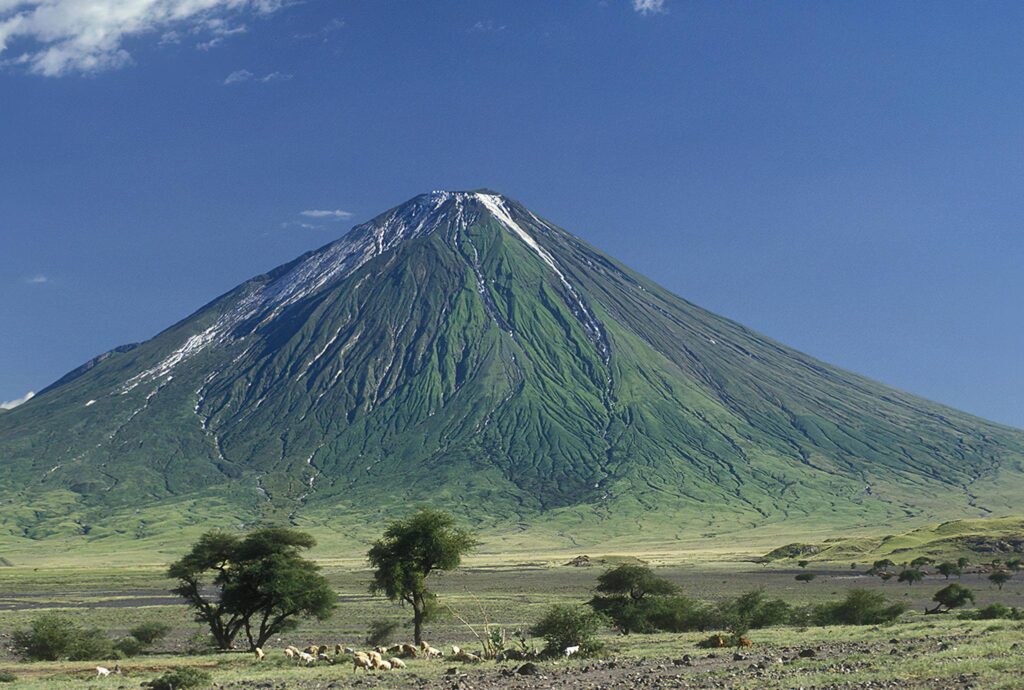Mount Ol’doinyo Lengai
By definition, “Oldoinyo Lengai” is “The Mountain of God” in Maasai. At an elevation of 2962 meters above sea level, the peak of this stratovolcano offers a direct view into the caldera of the only carbonatite volcano in the world—and the only officially-certified active volcano in Tanzania. Eruptions at this volcano have been documented since 1883, with the largest depositing ash 120 kilometers from Arusha Town and 100 kilometers northwest on the Kenyan border in Loliondo.
It is a sacred mountain in the eyes of the indigenous Maasai people and can be found in northern Tanzania, in the Rift Valley, not far from Soda Ash Lake Natron. From its top crater, one can see Lake Natron’s hot, desolate salt wastes stretching out into the distance to the north. The Ngorongoro Game Reserve and the crater Highlands are to the south. On one side, you can see Kilimanjaro, while on the other, you can see the hilly and forested escarpments that make up the Rift Valley’s western slopes. Smoke clouds rise from the crater of Mount Lengai once every seven years.
The floor of the crater can be traversed on foot. Due to the significant elevation increase, intense daytime heat, scarcity of water, and steep, unsuitable slopes composed of ash and brittle rocks, climbing Oldoinyo Lengai is a challenging undertaking. In a typical day, you can begin your ascent to the summit around dawn and reach the peak just before sunrise. The peak before dawn can be chilly, so it’s best to wear long pants and a heavy jacket for the ascent. An early descent from the peak in the morning shadow is possible via the access path from the north-west.
For generations, the Maasai people have prayed to their deity, NGAI, with the help of the Holly Lengai. The natrocarbonatite lava emitted by Ol’doinyo Lengai is unique among active volcanoes; this type of lava is far cooler than basaltic lavas, which contain more silicon and reach temperatures of around 1,100 degrees Celsius, compared to 510 degrees Celsius.
Minor eruptions of the mountain are common, and it often forms cone-like formations at the base of its crater.
The climb to the crater at the peak of Lengai takes around six or seven hours, longer than those of the other two highest mountains. Tourists accompanied by armed Maasai guides on a walking safari can see a wide variety of species, including olive baboons, velvet, monitor lizards, hyenas, lions, leopards, jackals, Grant’s gazelles, impala, and zebras, among many more.
Nearby, you’ll find the Maasai BOMAS, an opportunity to meet locals and gain insight into their traditions, customs, and taboos.
Climbing Ol’donyo Lengai
Nighttime is the best time to climb this 3,000-meter “Mountain of God,” as the Maasai name it. On Earth, this is the sole carbonatite volcano that is now spewing lava. This becomes an otherworldly and unique experience when lit by the moonlight. The view from the peak is breathtaking and difficult to put into words.
Because there are so many loose grains atop Ol’Doinyo Lengai, the hike to the peak is quite strenuous.
What you need to know is that the mountain conditions are changing every day. In the heat of the moment, the guide can call off the ascent.
Walk on Great Rift
Beautifulness abounds in the Great Rift Valley, which goes by several names: the Great Slenk, the East African Slenk, and others.
A lovely stroll along the Rift Valley can be enjoyed near Lake Natron. Today is a memorable occasion, especially with the magnificent Ol’Donyo Lengai in the backdrop.
Embark on this early morning stroll from the Lake Natron Camp. Continuing on foot, you will reach the base of the Rift Valley wall. You can reach the base of the Ngare Sero canyon by following this wall. Awakening at the peak is the reason you ascend this. As you dine on breakfast along the rim of this gorge, take in the spectacular scenery.
You will return to Lake Natron Camp by a different route after breakfast.
Waterfalls and Springs
A picturesque hike to the Engare Sero gorge, home to several springs and waterfalls, begins at Lake Natron Camp.
A half-day or full-day excursion is available to you. To cool off, you can swim at the waterfalls that you reach by walking there. The stunning combination of tropical palm trees and volcanic rocks creates this sanctuary.

